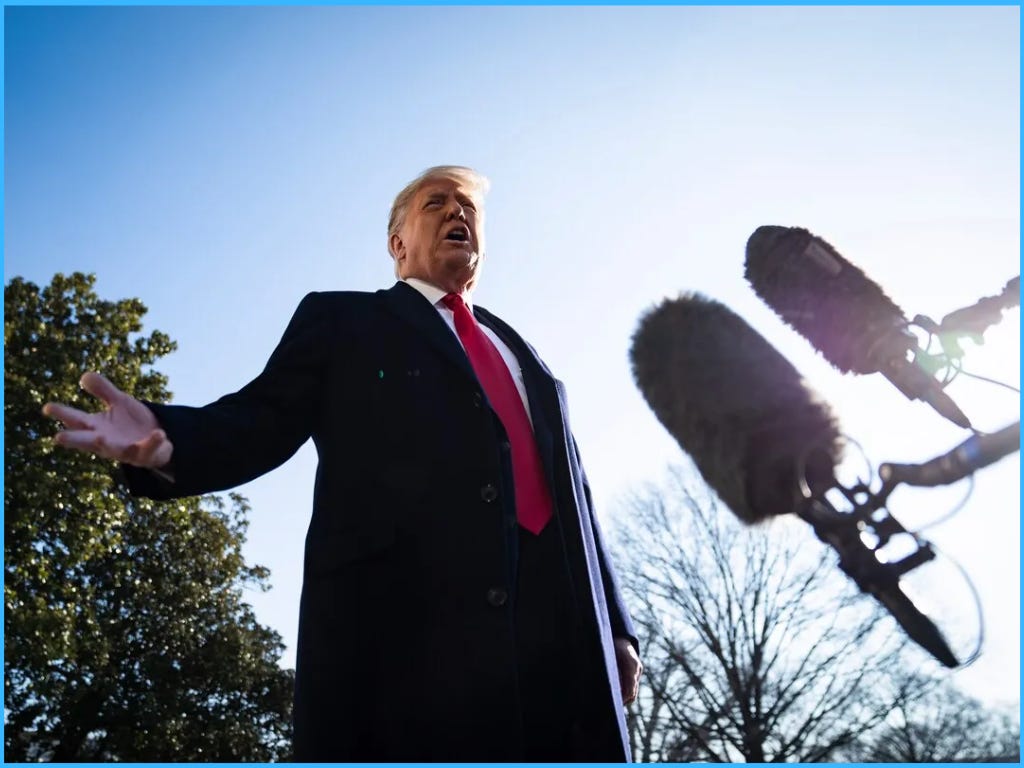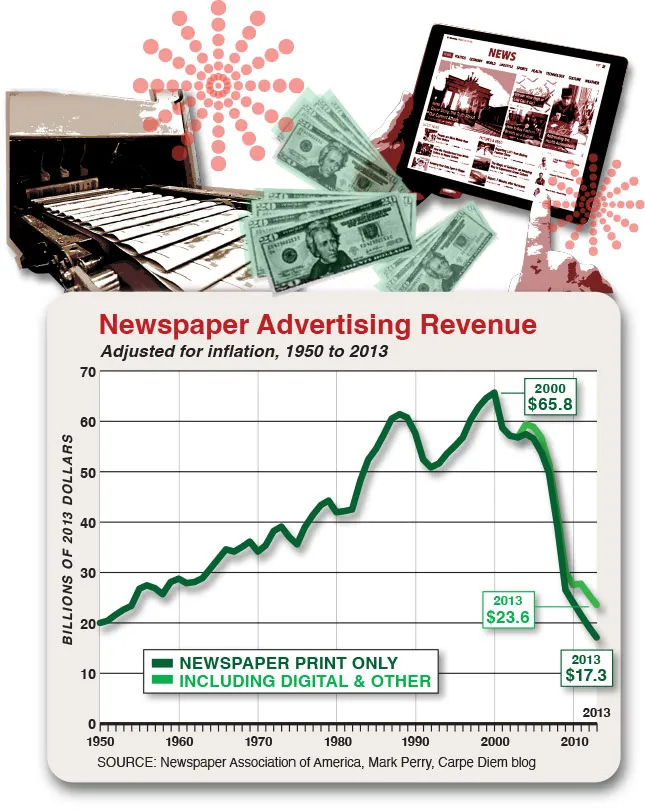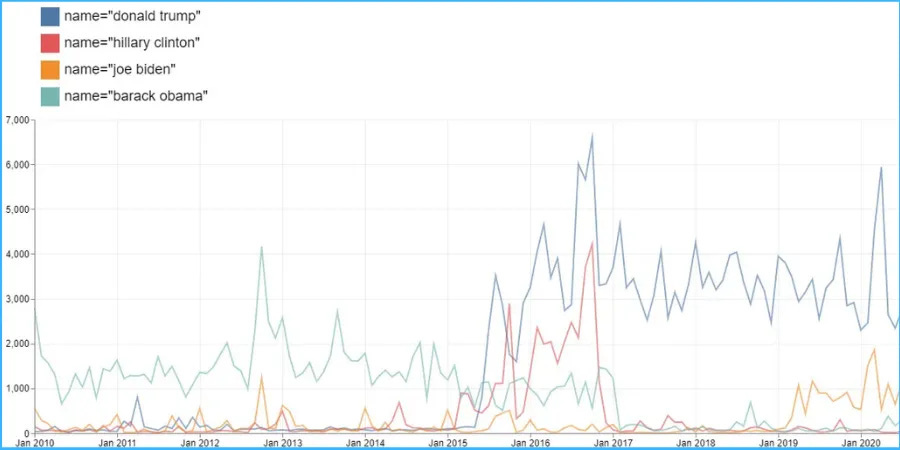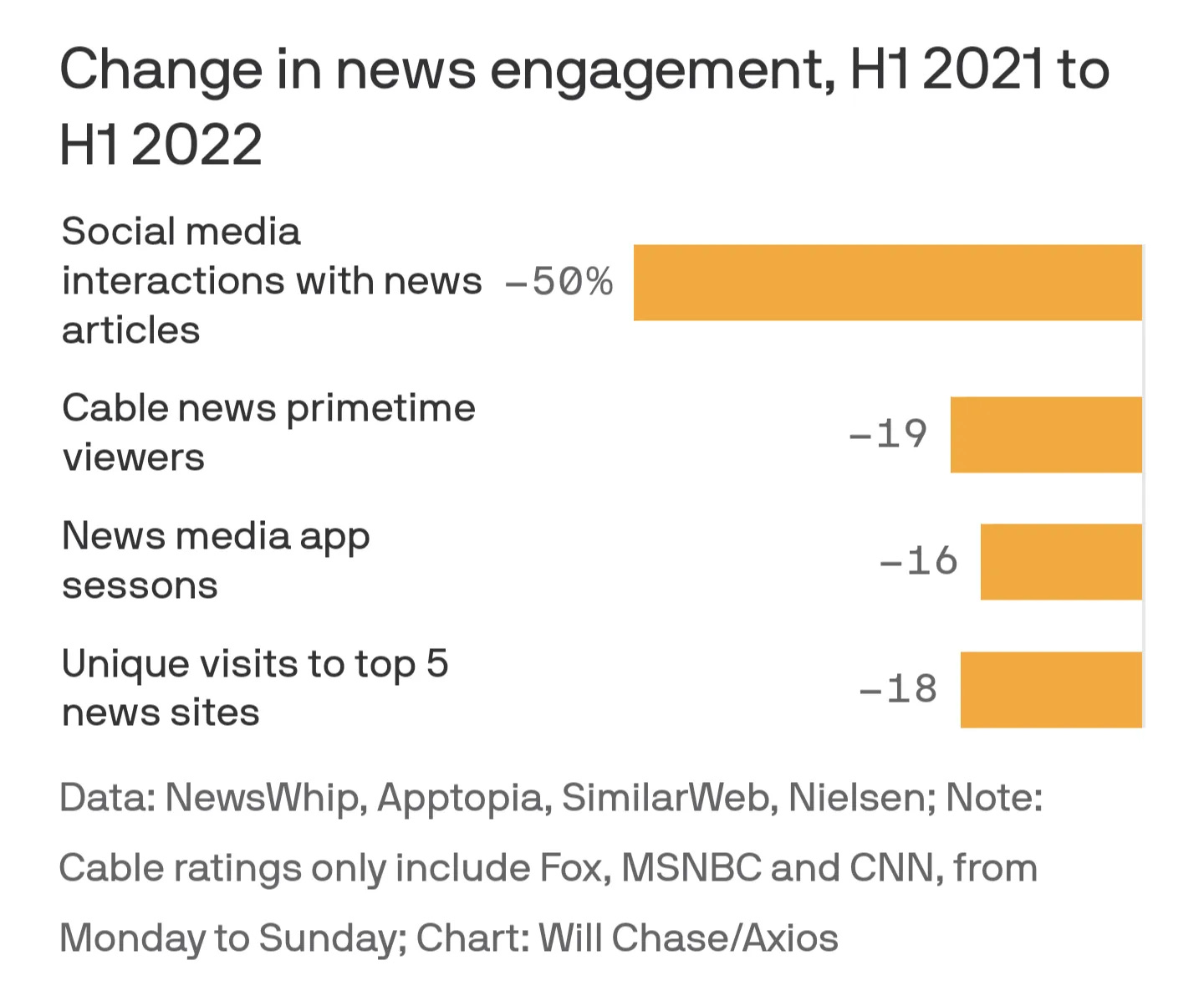How Trump Both Saved and Changed the Mainstream Media
And why they want him back.
The past decade has been a confusing time for the mainstream media.
On the one hand, the internet and the rise of social media have completely upended the concept of journalism, which had always depended on ad-funded news during a time when advertising accounted for most of the industry’s revenue. The internet’s digital tsunami of information that we discussed in a recent post crippled the traditional newspaper business model that had long endowed newsrooms with a sacrosanct authority as a gatekeeper to knowledge with a monopoly over dissemination. For hundreds of years publications relied predominantly on advertising for funding, but as ad money fled the industry in the early 2010s and resettled online, revenue dropped precipitously. According to a 2021 study by the Pew Research Center, advertising revenue cratered from $49.4 billion in 2005 to $9.6 billion in 2020.
On the other hand, the media’s ubiquity seems to have grown exponentially, and while some 2,000 dailies have gone silent since the turn of the century, the MSM began reporting strong readership and viewership numbers around 2016. But it wasn’t stellar reporting or excellent content that brought about the surge in numbers and ratings, it was the public’s feverish preoccupation with all things Donald Trump—a fixation that was seized upon, spurred on, and exploited. Trump made the MSM great again.
The MSM’s obsession with Trump remains undeniable. The former president received three times the amount of coverage that any of his predecessors did. Preoccupied with the idea of exposing him, the media consciously afforded enormous exposure assets to Trump for free from the beginning of the 2016 presidential campaign. In exchange, they received growth in audience attention and an increase in circulation and revenue.

In the chase for digital subscriptions — the new business model of an industry in dire straights — Trump was the ultimate bait.
At the beginning of Trump’s campaign, the New York Times had slightly over 1 million digital subscribers. The paper almost doubled that number by the time of Trump’s inauguration. According to CNBC, in the week following Trump’s win in November 2016 the New York Times acquired 132,000 paid subscribers—a growth rate tenfold of what it was during the same period the year prior.
The “Trump bump” helped to catapult digital subscriptions at the Times to a record-breaking 7 million in 2020—the first time the publisher brought in more revenue from online readers than its print subscribers.1
“Every time I hear [Trump] tweet about the ‘failing @nytimes’ or use the shopworn sobriquet ‘fake news,’ I also hear the ka-ching of the so-called Trump bump,” said former Times executive editor Jill Abramson. Or as former CBS chief executive officer Les Moonves put it, “[Trump] may not be good for America, but it’s damn good for CBS. The money’s rolling in. . . This is fun.”
An analysis published in the Columbia Journalism Review found that “the quantity of coverage devoted by the print media to Donald Trump is without historical precedent.” The article quantified the New York Times’ obsession with Trump.
According to the analysis, “in 2018, ‘Trump’ was the fourth most used word in the paper. On average, Trump was directly mentioned two to three times in every article, and indirectly mentioned an additional once or twice.”
The Times’ growth was not the exception. According to TheStreet, the Washington Post saw “doubled digital subscription revenue in [2016], with a 75% increase in new subscribers.” In July 2018, the Post’s vice-president of marketing, Miki Toliver King, presented a report ostensibly showing a correlation between marketing efforts and subscription success. This is risible. If you overlay the key events of Trump’s campaign onto the growth curve, you’ll see the real causation for the spike.
Magazines also went crazy. Between the November 8th election day and the end of January, the New Yorker sold 250,000 subscriptions—up 230% compared with the same three-month period a year prior. January alone produced 100,000 subscriptions, a 300% increase over January 2016. Similarly, The Atlantic saw an all-time record number of subscriptions in November 2016, and then proceeded to double those numbers the next month. Those two months accounted for one-third of all subscriptions placed online for the magazine that year.2
The Trump obsession was so all-consuming that in order for a story to be published, it became almost mandatory for writers to include the Bad Orange Man w/Mean Tweets. The Columbia Journalism Review reported that even placing international stories in American outlets was getting harder unless they directly involved The Donald. Book publishing was much the same. In 2018, each book at the top of the New York Times best-seller list shared one commonality: Trump.3
A tool from Stanford University’s Computer Graphics Lab reveals that cable news underwent a similar transformation. The Stanford Cable TV News Analyzer enables users to track cable news screen time for anyone they’d like, from 2010 to present. As Columbia Journalism Review’s Musa al-Gharbi pointed out, the media basically ran with 2016 campaign-level attention on Trump for four years straight.
During the 2016 campaign, from August 2015 to November 2016, cable news aired about two hours per day (123 minutes) of just Trump talking. And, of course, this was only a fraction of the total coverage, as every clip aired of Trump speaking was typically bookended with other MSM minions hyperventilating about what Trump was going to say or had just said—often building ten-minute segments out of two minutes of Trump talk. What’s most striking in the data, however, is what happened after the election—because almost nothing changed. In 2017, as Trump began his presidency, he averaged 110 minutes of speaking time per day; in 2018 it was 114 minutes; in 2019, 112 minutes; in 2020, 110 minutes.
Much like the press, Trump took cable news to stratospheric heights, with outlets enjoying huge increases in ad revenue by fetishizing the president. From his candidacy announcement in 2015 to his White House exit, he was the driving force behind record ratings and profits for CNN4 and MSNBC. Shows that focused heavily on Trump saw significant ratings boosts, among them Stephen Colbert, Rachel Maddow (of course), and Trevor Noah. Even Saturday Night Live with Alec Baldwin as Trump increased its viewership 44% in the 2016–2017 season.
If there should be any question as to whether the Trump bump was merely correlation, one need only look at what happened when Trump left office. News engagement and viewership numbers plummeted.
Trump predicted this. “Newspapers, television, all forms of media will tank if I’m not there,” he augured in 2017, “because without me, their ratings are going down the tubes.”
CNN remains in especially dire straights. With no antagonist, there’s no impetus, no sense of urgency compelling viewers to tune in. Indeed, just a few months into Biden’s presidency, the network had lost a staggering 58% of its key demographic audience. The year 2020 saw profitability drop below $1 billion for the first time since 2016. Employees even received a revised travel and expense policy that, among other things, restricts spending on work celebrations for senior vice presidents and below to $50 per person.
From Circus Coverage to Extremely Dangerous to Our Democracy™
The Trump bump was especially notable for the simple fact that historically, there have been few prolonged events as beneficial to the media outside of maybe both world wars. Trump’s resurrection of the MSM is all the more poignant because it occurred right in the midst of a press crisis that saw newsrooms go into desperation mode. As Martin Gurri wrote in The Revolt of the Public, “Media people pumped the helium that elevated Donald Trump’s balloon, and they did so from naked self-interest.” Or as comedian Michelle Wolf put it at the 2018 White House Correspondents’ Dinner when she blamed the congregation, “He’s helped you sell your papers and your books and your TV. You helped create this monster, and now you’re profiting off of him.”
It was very much a symbiotic relationship.
It’s not that the MSM was wrong to exploit Trump for a bump in clicks and subscribers and what have you; it’s how they did it. Objectivity was replaced with shrill, self-righteous advocacy journalism.
In a post I wrote back in August, I detailed the lengths that the MSM went to push the it’s-always-Trump’s-fault narrative, often outright lying. But they also profited from an artificially induced “Trump scare.” Immediately following his election, shrewd media executives realized that the whole amusement-type carnival coverage based on the what-if fairy tale they treated Trump’s campaign as all the way up to November 8, 2016 would no longer suffice.5 Trump as existential danger allowed them to commodify the Bad Orange Man scare, a transition that amplified the Trump bump rewards even more. Thus, the politicization of the media business began, contributing to society’s surge in polarization.
As Andrey Mir writes, “The media quickly learned to solicit subscriptions as support for a noble effort—the protection of democracy from ‘dying in darkness,’ as the Washington Post put it.” A new business model emerged, soliciting subscriptions as donations to a cause, with ideological values and anti-Trump content the crux of the commercial offer.
To keep numbers up and the money coming in, and to lure converts past the pesky paywall, the MSM had to successfully use what’s referred to in the PR world as “a call to action.” They settled on rhetoric specifically meant to incite fear and angst. At every possible occasion, Trump was portrayed as a demonic figure Extremely Dangerous to Our Democracy™, a madman who might well toy around with the nuclear codes for funsies on days that he got bored with Twitter, and whom no Good Person™ could possibly accept.
Notably, it wasn’t just Trump that they used for fear fodder, but the entire half of the electorate that supported him as well—the “MAGAts.” Ordinary Americans were vilified overnight, thereafter treated like some kind of mongol horde living amongst us in secret. Good People™ everywhere became paranoid: I just know Dave in accounting voted for that despicable man. I know it. I can just tell by the American flag sticker on the back of his car. That son of a bitch!
As polarizing agents within a new business model dependent on engagement and subscriptions, the MSM sells validation—of beliefs, not news. This is because nowadays the subscription-as-membership quality of paying for the news, which is the business model of a desperate, dying industry, means that people aren’t interested in the news so much as they are the news as presented from a certain angle. The New York Times, for example, is basically just a notary at this point. Its imprimatur and the fact that people know the Times is going to convey the news from the right perspective, that of the Good Person™, is why the paper has managed to survive the industry’s most turbulent years.6 Even if they don’t realize it, the vast majority of subscribers are paying to support a cause—that of ensuring a specific worldview, a specific creedo, is proselytized to others.
The MSM’s new reliance on digital subscriptions means that the advertising-dictated necessity to appeal to the median American and practice objectivity is no more. The inherent liberal predisposition of the newsrooms is now unchecked by any financial imperative. This has led to the development of “post-journalism”—essentially, commentary commodified and sold as the modern-day version of news but which is funded through subscriptions, which are in turn solicited as donations. This new form of journalism sells not the news, not even the truth necessarily, but an ethos and an agenda to like-minded people; it identifies and exploits the ideological fears and values of a specific audience, then cultivates the content that audience will buy as part of a constructed worldview that can be altered to seduce.
Just like with voting, this hybrid transactional scheme requires a call to action, a reason for donating—a trigger, if you will. It can be something as seemingly insignificant as a picture of Trump’s mouth next to a subscription discount ↑, because the best triggers are emotions, particularly fear and anger and outrage and angst, and as we all know well, the Trump Derangement Syndrome-afflicted are extremely sensitive to all things Bad Orange Man w/Mean Tweets.
There’s a very obvious, but rarely acknowledged conflict of interest at play here vis-à-vis the MSM’s continued Trump sensationalism: They’re profiting off of that which they pretend to be against. It’s to their benefit for Trump and his populist movement to remain relevant. Indeed, another four years of Trump in the White House would be the best thing that could happen to the MSM. It would be another boon.
As the 2024 presidential election draws closer, be on the lookout for something: The MSM and the “Never-Trump” crowd subtly throwing support behind Trump and attacking his primary opponents. We’re already beginning to see this happen. They want him back.
Even single-copy newsstand sales — what TheStreet calls “the laggard of magazine sales” — jumped both in January (with a 40,000-issue reprint, due to demand) and 15% for the year.
The Trump bump even resulted in an admission surge in journalism schools.
2016 was the most profitable year in CNN’s history.
Remember, Trump’s victory was one of the biggest upsets in world history, not necessarily because of how many people were shocked by the outcome, though that number was certainly massive, but because of who it shocked: The elite class, of which our MSM commentariat are part. “The polls are split between Clinton winning and … Clinton winning in a landslide,” read one CNBC headline just weeks before the election. The media had no plans to continue coverage of Trump beyond maybe a last few jabs upon his defeat.
Not every news purveyor was saved by the “Trump bump.” The phenomenon didn’t stop the collapse of local newspapers; rather, it concentrated authority in the national big fish. Partisan subscribers were only interested in subsidizing the outlets that Trump attacked.
















It's a difficult needle to thread for the media: bashing Trump 24/7 and promising to put him in jail, but also ensuring that he's the nominee in 2024.
Once upon a time there was a bear and a rabbit.
The bear was taking a shit in the woods when he asked the rabbit if he had problems with shit sticking to its fur.
The rabbit said no so the bear wiped his ass with the rabbit.